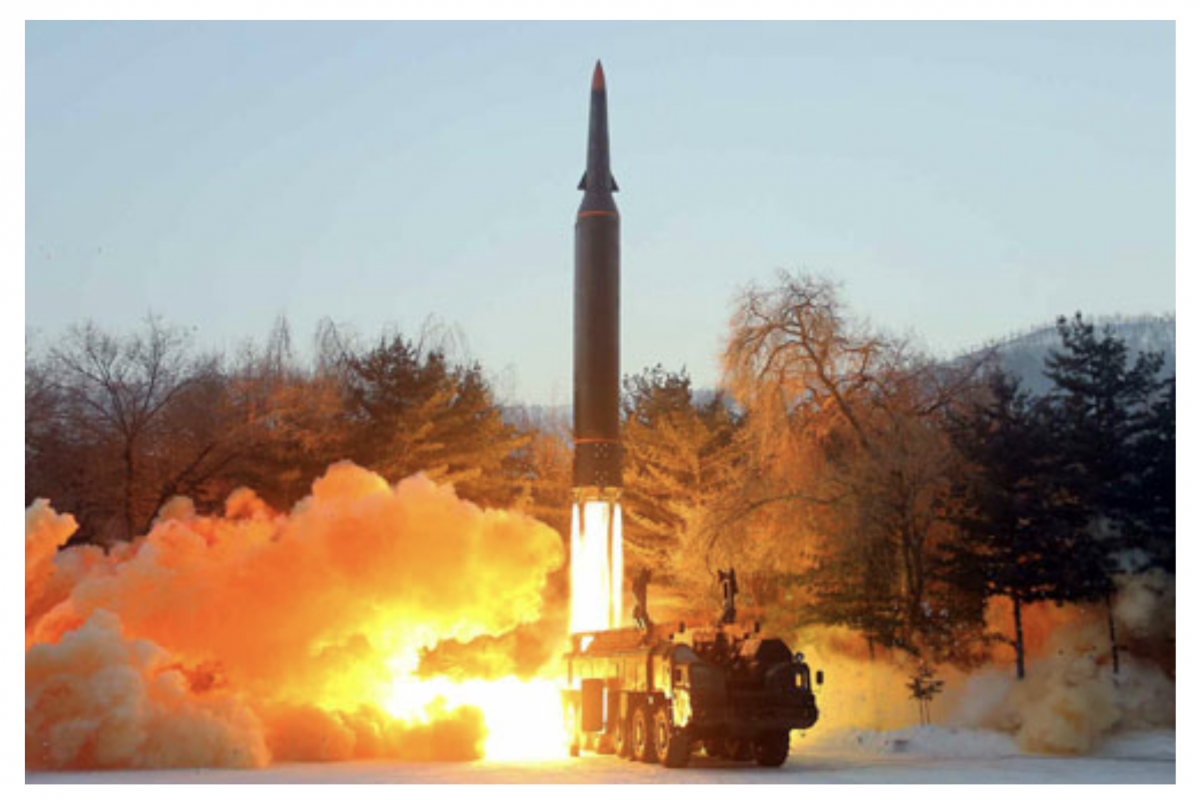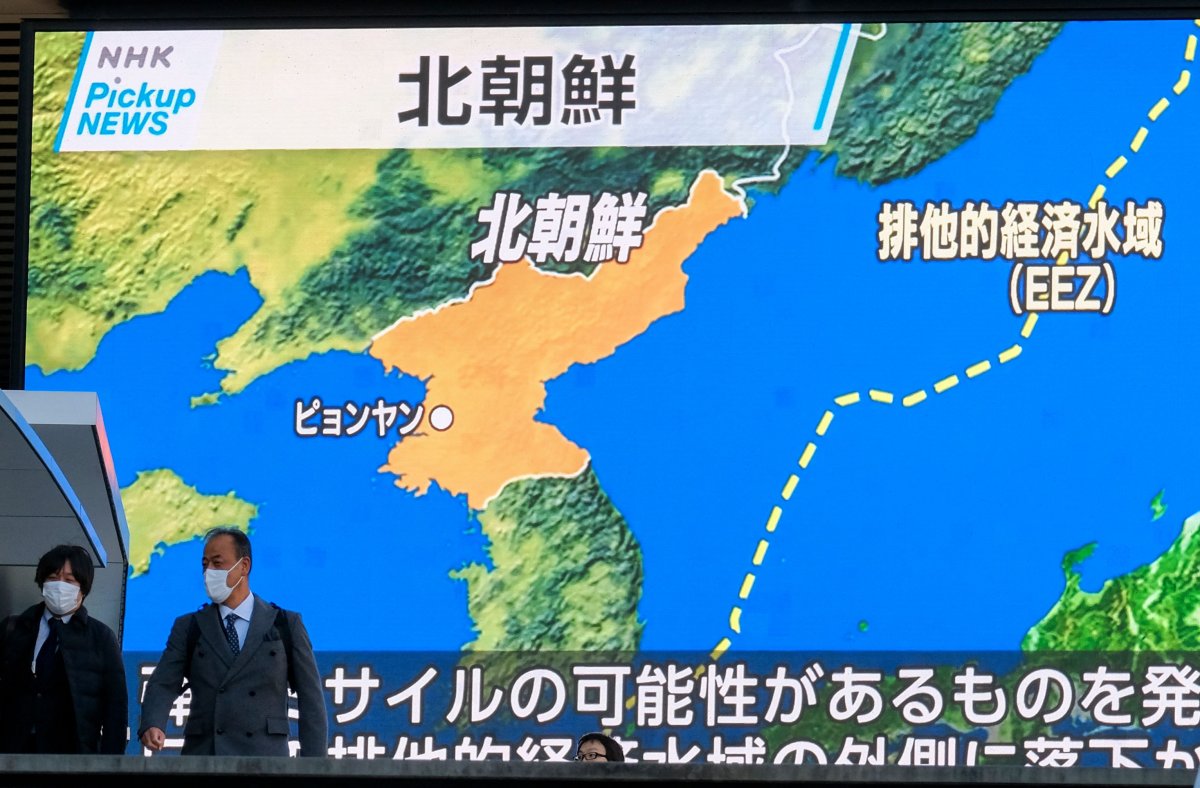North Korea's state-run media has announced the test of a maneuverable hypersonic missile system celebrated by Supreme Leader Kim Jong Un's government as the latest in a series of successes in the defense realm.
And though the secretive, militarized state is far from the only country to seek this kind of technology, experts say the deployment of such a weapon gives North Korea an edge when it comes to overcoming the defenses put in place by the United States and allies such as Japan and South Korea, while at the same giving Kim a victory on the domestic front at a time of acknowledged hardship for his country.
News of the launch first came Tuesday as the Japanese and South Korean militaries separately announced they had detected a likely North Korean missile launch that flew hundreds of miles eastward toward before falling at sea.
Confirmation of the test came Wednesday as official North Korean news outlets such as the Korean Central News Agency announced that the country's Academy of Defense Science "test-fired a hypersonic missile" a day before under observation from the ruling Korean Workers' Party Central Committee Munitions Industry.
"The successive successes in the test launches in the hypersonic missile sector have strategic significance in that they hasten a task for modernizing strategic armed force of the state put forward at the 8th Party Congress and help fulfill the most important core task out of the five top priority tasks for the strategic arms sector in the five year plan," KCNA reported.
This level of importance of the weapon to Kim's military plans, as well as the appearance of a model seen on display at an October defense exposition attended by the ruler himself, were noted by Jeffrey Lewis, who serves as director of the East Asia Nonproliferation Program at the Middlebury Institute of International Studies' James Martin Center for Nonproliferation Studies.
He described the missile in question as "a maneuvering warhead, similar to the Pershing II that the U.S. deployed in Europe in the 1980s."
"It's being called a 'hypersonic' warhead, which is true but misleading since all long-range missiles are hypersonic," he told Newsweek.
What's different about a maneuverable warhead is that it allows the operator to control path of the weapon mid-flight, making it exceeding difficult to intercept at speeds exceeding five times the speed of sound.
"A maneuvering warhead improves North Korea's ability to defeat U.S. and allied missile defenses," Lewis said.

KCNA reported that Tuesday's launch "reconfirmed the flight control and stability of the missile in the active-flight stage and assessed the performance of the new lateral movement technique applied to the detached hypersonic gliding warhead."
"Having been detached after its launch, the missile made a 120 km [about 76 miles] lateral movement in the flight distance of the hypersonic gliding warhead from the initial launch azimuth to the target azimuth and precisely hit a set target 700 km [about 435 miles] away," KCNA wrote.
The demonstrations was also said to have proven "the reliability of fuel ampoule system under the winter weather conditions" as well as "the control and stability of the hypersonic gliding warhead which combined the multi-stage gliding jump flight and the strong lateral movement."
While the U.S. pioneered boost-glide ballistic missile technology in the 1980s and continues to work on fielding such technology today it was Russia that unveiled such a weapon during a dramatic 2018 presentation by President Vladimir Putin who declared the vehicle now known as Avangard to be invincible to all existing defense systems.
Lewis pointed out that other countries in the region such as China, South Korea and Japan "have or are developing maneuvering warheads" comparable to that being tested by North Korea but the capabilities remain relatively rare among the nations of the world.
Ankit Panda, another leading analyst who serves as a senior fellow in the Nuclear Policy Program at the Carnegie Endowment for International Peace, said that "exhibiting such a capability does put the North Koreans in a small club—even if the capability is not the most sophisticated in its class or perfected."
On the military front, Panda said Kim's focus on honing hypersonic capabilities "is probably because he perceives these weapons to be good at coping with missile defenses," albeit without their own vulnerabilities.
"This newly tested missile, according to the North Koreans, exhibited both vertical and lateral maneuvers in flight and could thus be challenging to track and defend against, but not impossible," Panda said. "These weapons are not invulnerable, superweapons, but a class of missiles that are growing in popularity around the world—with the superpowers Russia, China and the United States really leading the charge."
"Under Kim," Panda added, "there's been a big emphasis not only on military self-sufficiency but defense scientific excellence."
And at home, there was another likely motivation for such exhibitions that regularly grab the world's attention.
"At a time when Kim has been open about economic difficulties within North Korea, a demonstration like this one could go a long way to shore up morale—if not with ordinary North Korean people, then at least the military and the core of the Workers' Party," Panda said.
Sue Mi Terry, Director of the Hyundai Motor-Korea Foundation Center for Korean and Public Policy at The Wilson Center, also noted that, "as the economic situation worsens in North Korea, Kim could use more provocations such as missile tests in an attempt to extract more aid from the outside world."
"But we shouldn't be panicked or over-react to one more missile test," Terry said in a statement shared with Newsweek. "Kim is simply running the North's tried and true playbook of using provocations to increase his international leverage and ability to coerce more concessions from the United States."
Terry also noted that Tuesday's test was only the latest in a long line of recent demonstrations that also includeda new surface-to-air defense missile system, a long-range cruise missile, a train-based ballistic missile and a new submarine-launched ballistic missile, another development that puts North Korea in a category of a select few nations only recently joined by rival South Korea.
She said the developments were all part of Kim's stated plan "to create a nuclear triad that can survive a first strike and to develop weapons that can evade existing missile defense systems," and that "we should expect more to come."

And while Kim resumed missile launches amid a breakdown in denuclearization-for-peace talks with the U.S. in May 2019, ending a nearly year-and-a-half-long pause, he has yet to return to nuclear weapons and longer-range missile tests. And Kim has not ruled out talks with Washington even as he demands President Joe Biden's administration first cease its "hostile policy" toward Pyongyang, which is subject to strict international sanctions, before establishing meaningful contact.
But there's been little progress on this front. Regardless, South Korean President Moon Jae-in has pressed forward with an attempt to once and for all put an end to the war that erupted between the two neighbors at the onset of the Cold War in the 1950s.
As Moon approaches his final weeks in office with elections coming up in March that could very well see a more conservative shift for South Korea, his administration was joined by the U.S. in appealing to North Korea to answer calls for dialogue that have so far gone largely ignored.
While Korean Workers' Party Central Committee Vice Department Director Kim Yo Jong, who is also Kim Jong Un's sister, initially said she was "interested" in Moon's offer to declare a lasting peace on the Korean Peninsula, little more has emerged from Pyongyang as Moon moved forward with the initiative amid consultations with the U.S. and China.
Kim Jong Un's most recent remarks, including his late December appearance at the fourth Plenary Meeting of the 8th Central Committee of the Korean Workers' Party have placed greater emphasis on shoring up national development, with regular references to bolstering national defense as well.
Speaking at the plenary meeting, Kim Jong Un was said to have remarked how "the military environment of the Korean peninsula and the trend of the international situation getting instable day after day demand that bolstering the state defence capability be further powerfully propelled without a moment's delay," according to KCNA.
He called for his defense sector to press forward with the development of new, modern armaments as well as for the boosting of North Korea's already multimillion-strong militias.
But Kim Jong Un also linked North Korea's upcoming military moves to the trajectory of the country's relationship with South Korea and others.
"The conclusion set forth principled issues and a series of tactical orientation," the KCNA report noted, "all of which should be maintained by the sectors of the north-south relations and external affairs to cope with the rapidly changing international political situation and the circumstances in the surroundings."

Uncommon Knowledge
Newsweek is committed to challenging conventional wisdom and finding connections in the search for common ground.
Newsweek is committed to challenging conventional wisdom and finding connections in the search for common ground.
About the writer
Based in his hometown of Staten Island, New York City, Tom O'Connor is an award-winning Senior Writer of Foreign Policy ... Read more
To read how Newsweek uses AI as a newsroom tool, Click here.








